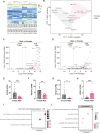Healthy human induced pluripotent stem cell-derived cardiomyocytes exhibit sex dimorphism even without the addition of hormones
- PMID: 40578843
- PMCID: PMC12371235
- DOI: 10.1093/stmcls/sxaf038
Healthy human induced pluripotent stem cell-derived cardiomyocytes exhibit sex dimorphism even without the addition of hormones
Abstract
Human induced pluripotent stem cell-derived cardiomyocytes (hiPSC-CMs) are a valuable cell type for studying human cardiac health and disease in vitro. However, it is not known whether hiPSC-CMs display sex dimorphism and therefore whether sex should be incorporated as a biological variable in in vitro studies that include this cell type. To date, the vast majority of studies that utilize hiPSC-CMs do not include both male and female sex nor stratify results based on sex because it is challenging to amass such a cohort of cells. Here, we generated 3 female and 3 male hiPSC lines from adult left ventricular cardiac fibroblasts as a resource for studying sex differences in in vitro cardiac models. We used this resource to generate hiPSC-CMs and maintained them in basal media without exogenous hormones. Functional assessment of CMs showed enhanced calcium handling in female-derived hiPSC-CMs relative to male. Bulk RNA sequencing revealed over 300 differentially expressed genes (DEGs) between male and female hiPSC-CMs. Gene ontology analysis of DEGs showed distinct differences in pathways related to cardiac pathology including cell-cell adhesion, metabolic processes, and response to ischemic stress. Differential expression of the sodium channel auxiliary unit SCN3B was found and validated through patch-clamp measurements of sodium currents, showing increased peak amplitude and window current in female hiPSC-CMs. These findings highlight the importance of considering sex as a variable when conducting studies to evaluate aspects of human cardiac health and disease related to CM function.
Keywords: adhesion receptors; calcium flux; cardiac; iPS; induced pluripotent stem cells.
© The Author(s) 2025. Published by Oxford University Press.
Conflict of interest statement
None declared.
Figures




Similar articles
-
Prescription of Controlled Substances: Benefits and Risks.2025 Jul 6. In: StatPearls [Internet]. Treasure Island (FL): StatPearls Publishing; 2025 Jan–. 2025 Jul 6. In: StatPearls [Internet]. Treasure Island (FL): StatPearls Publishing; 2025 Jan–. PMID: 30726003 Free Books & Documents.
-
DMSO-free cryopreservation of hiPSC-derived cardiomyocytes: low temperature characterization and protocol development.Stem Cell Res Ther. 2025 Jun 10;16(1):301. doi: 10.1186/s13287-025-04384-5. Stem Cell Res Ther. 2025. PMID: 40495211 Free PMC article.
-
Stimulating Calcium Handling in hiPSC-Derived Engineered Cardiac Tissues Enhances Force Production.Stem Cells Transl Med. 2022 Mar 3;11(1):97-106. doi: 10.1093/stcltm/szab002. Stem Cells Transl Med. 2022. PMID: 35641165 Free PMC article.
-
Metabolic impacts of long-chain fatty acids on cardiomyocyte maturation in neonatal mammalian hearts.Methods. 2025 Sep;241:114-127. doi: 10.1016/j.ymeth.2025.05.010. Epub 2025 May 29. Methods. 2025. PMID: 40449856 Review.
-
Human iPSC-Cardiomyocytes as an Experimental Model to Study Epigenetic Modifiers of Electrophysiology.Cells. 2022 Jan 7;11(2):200. doi: 10.3390/cells11020200. Cells. 2022. PMID: 35053315 Free PMC article. Review.
References
-
- Heron M. Deaths: Leading Causes for 2019. Natl Vital Stat Rep. 2021;70:1-114. - PubMed
-
- Lian X, Hsiao C, Wilson G, et al. Robust cardiomyocyte differentiation from human pluripotent stem cells via temporal modulation of canonical Wnt signaling. Proc Natl Acad Sci. 2012;109:E1848-E1857. https://doi.org/ 10.1073/pnas.1200250109 - DOI - PMC - PubMed
-
- Lian X, Zhang J, Azarin SM, et al. Directed cardiomyocyte differentiation from human pluripotent stem cells by modulating Wnt/β-catenin signaling under fully defined conditions. Nat Protoc. 2013;8:162-175. https://doi.org/ 10.1038/nprot.2012.150 - DOI - PMC - PubMed
-
- Paige SL, Osugi T, Afanasiev OK, et al. Endogenous Wnt/β-catenin signaling is required for cardiac differentiation in human embryonic stem cells. PLoS One. 2010;5:e11134. https://doi.org/ 10.1371/journal.pone.0011134 - DOI - PMC - PubMed
-
- Regitz-Zagrosek V. Sex and gender differences in heart failure. Int J Heart Fail. 2020;2:157-181. https://doi.org/ 10.36628/ijhf.2020.0004 - DOI - PMC - PubMed
MeSH terms
Substances
Grants and funding
LinkOut - more resources
Full Text Sources
Medical

